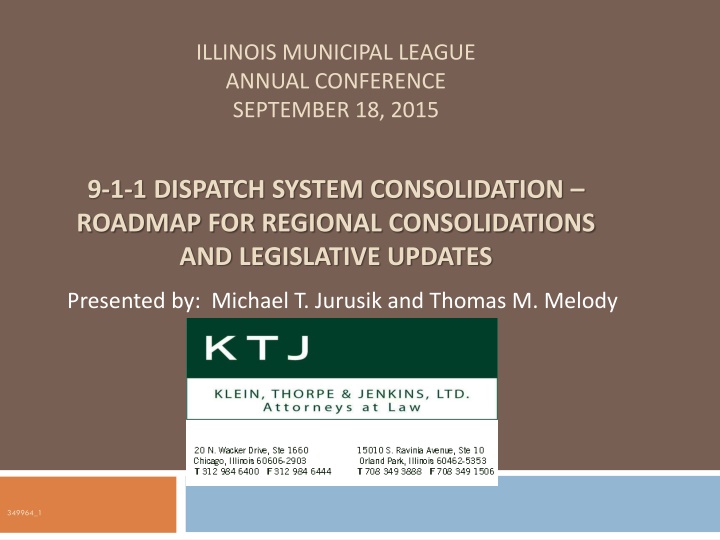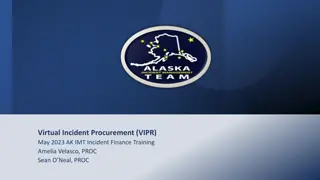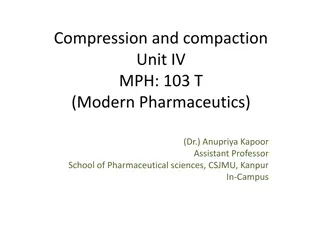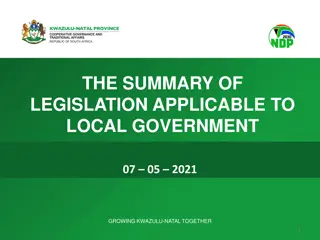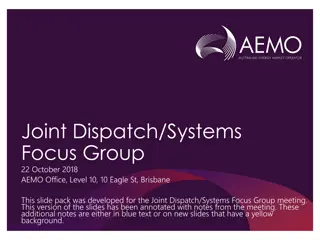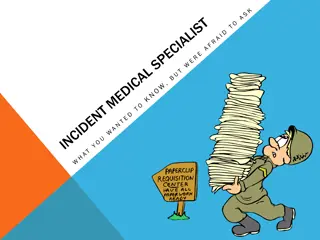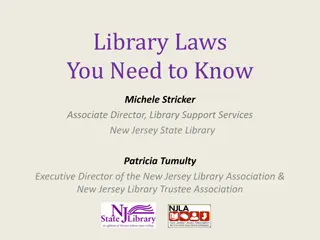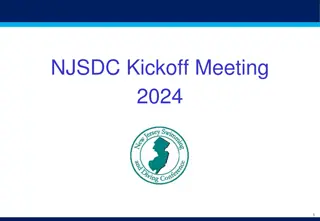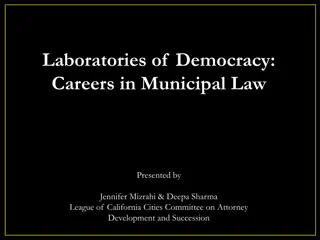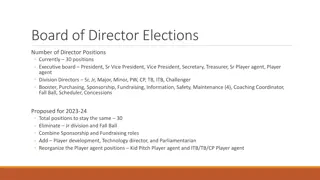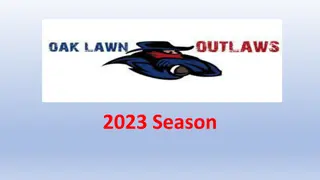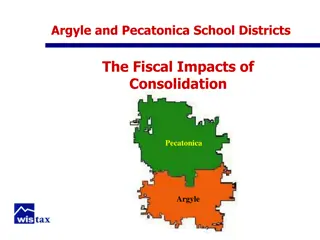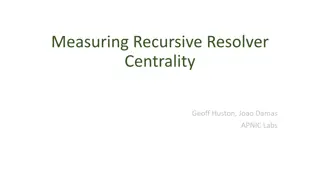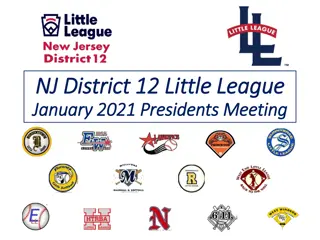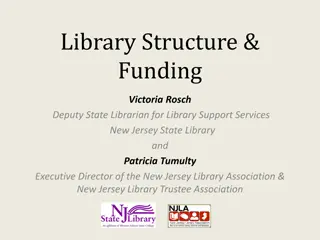Illinois Municipal League Annual Conference on 9-1-1 Dispatch System Consolidation
Explore the benefits and framework for consolidating 9-1-1 dispatch systems in Illinois, including reasons for consolidation, authority under state laws, and legislative updates. Learn about cost savings, resource sharing, and compliance mandates driving regional consolidations. Discover how intergovernmental cooperation laws enable joint exercises among public agencies for enhanced emergency services.
Uploaded on Oct 01, 2024 | 4 Views
Download Presentation

Please find below an Image/Link to download the presentation.
The content on the website is provided AS IS for your information and personal use only. It may not be sold, licensed, or shared on other websites without obtaining consent from the author.If you encounter any issues during the download, it is possible that the publisher has removed the file from their server.
You are allowed to download the files provided on this website for personal or commercial use, subject to the condition that they are used lawfully. All files are the property of their respective owners.
The content on the website is provided AS IS for your information and personal use only. It may not be sold, licensed, or shared on other websites without obtaining consent from the author.
E N D
Presentation Transcript
ILLINOIS MUNICIPAL LEAGUE ANNUAL CONFERENCE SEPTEMBER 18, 2015 9-1-1 DISPATCH SYSTEM CONSOLIDATION ROADMAP FOR REGIONAL CONSOLIDATIONS AND LEGISLATIVE UPDATES Presented by: Michael T. Jurusik and Thomas M. Melody 349964_1
Introduction: Why Consolidate? Consistency 9-1-1 service varies throughout the State and operational costs differ greatly from system to system Allows better telecommunicators-to-caller ratios, allowing 9-1-1 systems to better manage human resources Cost Savings Reduces network costs and personnel costs Shared resources Compliance New Illinois legislation mandates many 9-1-1 systems consolidate in the near future 349964_1
Authority to Consolidate: State Laws There has been a longstanding policy promoting intergovernmental cooperation and consolidation driven by State law Illinois Constitution of 1970, Article VII, Section 10 Units of local government and school districts may contract or otherwise associate among themselves, with the State, with other states and their units of local government and school districts, and with the United States to obtain or share services and to exercise, combine, or transfer any power or function, in any manner not prohibited by law or by ordinance. 349964_1
Authority to Consolidate: State Laws Illinois Intergovernmental Cooperation Act (5 ILCS 220/1 et seq.) Intergovernmental cooperation. Any power or powers, privileges, functions, or authority exercised or which may be exercised by a public agency of this State may be exercised, combined, transferred, and enjoyed jointly with any other public agency of this State and jointly with any public agency of any other state or of the United States to the extent that laws of such other state or of the United States do not prohibit joint exercise or enjoyment and except where specifically and expressly prohibited by law. 5 ILCS 220/3. Emergency Telephone System Act (50 ILCS 750/1 et seq.) Any 2 or more municipalities, counties, or combination thereof, that impose a surcharge under Section 15.3 may, instead of establishing individual boards, establish by intergovernmental agreement a Joint Emergency Telephone System Board pursuant to this Section. The manner of appointment of such a joint board shall be prescribed in the agreement. 50 ILCS 750/15.4. Wireless Emergency Telephone Safety Act (50 ILCS 751/1 et seq.) In addition, 2 or more emergency telephone system boards or qualified units of local government may, by virtue of an intergovernmental agreement, provide wireless 9-1-1 service. 50 ILCS 751/15. 349964_1
Relevant Statutes for Consolidation Emergency Telephone Systems Act (ETSA) 50 ILCS 750 et seq. Wireless Emergency Telephone Safety Act (WETSA) 50 ILCS 751 et seq. Prepaid Wireless 9-1-1 Surcharge Act 50 ILCS 753 Department of State Police Law 20 ILCS 2605-52 (Office of Statewide 9-1-1 Administrator) Illinois Administrative Code (83 Ill. Admin. Code. 725.200(i)) 349964_1
Emergency Telephone Systems Act, 50 ILCS 750/1 et seq. Created in 1975, the ETSA authorizes units of local government to hold local referenda to establish Emergency Telephone System Boards (ETSBs) to manage and operate 9-1-1 systems and impose wireline surcharges. Each ETSB is responsible for managing and making all critical decisions for the local jurisdiction s 9-1-1 system design, maintenance, and daily operations. Telecommunication carriers collect surcharges and remit the surcharge within 30 days to the ETSB, but each carrier and Voice Over Internet Protocol (VoIP) provider can deduct 3% of the gross amount of the surcharge for administrative costs. 349964_1
Wireless Emergency Telephone Safety Act, 50 ILCS 751/1 et seq. Was established when people began using cell phones more than landlines to promote the use of wireless 9-1-1 service Established a $0.73 per month surcharge on wireless carriers (a pass-through charge to their customers) $0.1475 of the surcharge goes to the Wireless Carrier Reimbursement Fund (WCRF) established to reimburse wireless carriers for administrative costs $0.5825 of the surcharge goes to the Wireless Service Emergency Fund (WSEF) established to make monthly grants to 9-1-1 systems to assist with costs incurred to provide wireless 9-1-1 services 349964_1
Prepaid Wireless 9-1-1 Surcharge Act, 50 ILCS 753/1 et seq. Required the imposition of a 1.5% surcharge to be collected at the point of sale of any prepaid wireless transaction in Illinois, except for Chicago Goes to the WSEF to be allocated to 9-1-1 systems in a prorated manner based on zip codes of post paid wireless customers. 349964_1
New Legislation: Public Act 99-0006 SB 0096 was signed by Gov. Rauner on July 2, 2015 Combines all three of current laws (Wireline, Wireless, and Pre-Paid) into one under the Emergency Telephone Systems Act, 50 ILCS 750 Creates Statewide 9-1-1 Advisory Board and Office of Statewide 9-1-1 Administrator under the Department of State Police Transfers the regulatory functions and powers the Illinois Commerce Commission (ICC) had under ETSA and WETSA to the Department of State Police. As of January 1, 2016, 9-1-1 Administrator will develop, implement and oversee a uniform statewide 9-1-1 system, for all areas of the State of Illinois outside of municipalities having a population over 500,000 (20 ILCS 2605-52) Creates uniform surcharge rate Calls for creation of 9-1-1 systems where they do not exist (e.g., rural areas) either via ETSBs, Joint ETSBs or Qualified Governmental Entities (QGE) (units of local government authorized to provide 9-1-1 services where no ETSB exists) Calls for consolidation of covered 9-1-1 systems by July 1, 2017 349964_1
Enhanced Public Safety and New Technology is driving consolidation efforts The legislation s policy goals are to establish 9-1-1 systems where they do not exist and consolidate and upgrade 9-1-1 systems where they do exist so that 9-1-1 services are available on a statewide basis. New and improved communications technology makes this feasible. Next generation 9-1-1 Systems ( NG9-1-1 System ) are now available and represent the next step forward in the evolution of delivery of 9-1-1 services. NG9-1-1 System means an Internet Protocol-based (IP-based) system of technology and databases that replicates E9-1-1 features and functions and provides additional capabilities. Designed to provide access to emergency services from all connected communication sources and provide multi-media data capabilities for Public Safety Answering Points (PSAPs) and emergency service organizations.
New Legislation: P.A. 99-0006 Uniform Surcharge OLD WAY NEW WAY Wireline (fixed location and VoIP) Rate set by local referendum $0.00 to $5.00/month/line statewide Wireless Rate was set by law at $0.73/month/line statewide Prepaid Wireless 1.5% Point-of-sale Wireline (fixed location and VoIP)* Rate set by law $0.87 statewide for all ETSBs and 9-1-1 Authorities Wireless Rate set by law at $0.87 statewide Prepaid Wireless 3% Point-of-Sale *Distribution formula makes adjustments to have all ETSBs made whole where current rates may be over $0.87, aka Hold Harmless 349964_1
New Legislation: P.A. 99-0006 Consolidation of 9-1-1 Systems by July 1, 2017 All units of local government: After January 1, 2016, no new ETSBs can be created by any municipality or county. Any consolidation via intergovernmental agreement to create a Joint ETSB must include the rescinding of the ordinances that created the original ETSBs. Consolidation Grants (50 ILCS 750/15.4b): 9-1-1 Advisory Board and 9-1-1 Administrator administer a 9-1-1 System Consolidation Grant Program to provide grants to defray the costs associated with 9-1-1 system consolidations for municipalities with populations less than 500,000. New law contains seven categories of Required Consolidations: 50 ILCS 750/15.4(a) Waiver available from mandated consolidations: 9-1-1- Administrator must find that consolidation will result in substantial threat to public safety, is economically unreasonable or is technically infeasible. 50 ILCS 750/15.4(c)
New Legislation: P.A. 99-0006 Consolidation of 9-1-1 Systems by July 1, 2017 Required Consolidations: A county with at least 250,000 population having a single ETSB or QGE and more than 2 PSAPs, the number of PSAPs must be reduced by at least 50% or to 2 PSAPs, whichever is greater. A county with at least 250,000 population having more than one ETSB or QGE serving a population of less than 25,000 shall be consolidated so that no ETSB in the county serves a population of less than 25,000. A county with at least 250,000 (but <1M), having more than one ETSB, Joint ETSB, or QGE, each 9-1-1 system shall reduce the number of PSAPS by at least 50% or to 2 PSAPs, whichever is greater. Nothing shall preclude consolidation of ETSBs, Joint ETSBs, or QGE into one Joint ETSB. 349964_1
New Legislation: P.A. 99-0006 Consolidation of 9-1-1 Systems by July 1, 2017 Any county with a population of less than 250,000 having a single ETSB or QGE and more than 2 PSAPs, the number of the PSAPs shall be reduced by at least 50% or to 2 PSAPs, whichever is greater. Any county with a population of less than 250,000 that has more than one ETSB, Joint ETSB or QGE and more than 2 PSAPs, the ETSBs shall consolidate into a single Joint ETSB, and the number of PSAPs shall be reduced by at least 50% or to 2 PSAPs, whichever is greater. Any ETSBthat does not have a PSAP within its jurisdiction shall be consolidated through an IGA with an existing ETSB that has a PSAP to create a Joint ETSB. The corporate authorities of each county that has no 9-1-1 service as of January 1, 2016must provide enhanced 9-1-1 wireline and wireless enhanced 9-1-1 service for the county either by an IGA with an existing ETSB (creating a Joint ETSB) or by an IGA with an existing Joint ETSB. NOTE: New consolidation law states that consolidation can result in one PSAP per county.
New Legislation: P.A. 99-0006 Phase out of Wireless Carrier Fund NEW Shift Carrier Reimbursement Fund to grants funds for consolidation and NG9-1- 1 over time OLD Current, $0.05 of the current $0.73 $0.04 for cellular system improvements for wireless call handling and other purposes $0.01 for administration and compliance Change rate to $0.033 After year 2, start to phase out Eventually eliminate all together after 5 years Shift funds to grants as it is phased out The Wireless Carrier Reimbursement Fund (WCRF) is to be phased out and eliminated by July 1, 2022. After that, wireless carriers would be able to deduct 3% of the surcharge to pay for administrative costs in the same manner as wireline carriers.
Method of Consolidation Intergovernmental Agreements Intergovernmental agreements ( IGA ) are the key component to effective 9-1-1- consolidations During the preliminary phase, IGAs should be used by public bodies to reach agreement on terms regarding the study and evaluation of the feasibility of consolidation and to share costs (e.g., professional fees for feasibility study) regarding consolidation efforts. For the long-term commitment phase, IGAs should be used to establish an intergovernmental cooperative venture for the operation and maintenance of a centralized, combined emergency services dispatch and communication system, for the purpose of providing facilities, equipment, personnel, software and hardware, data processing and all other services necessary or incidental to: (1) the provision of emergency and/or municipal dispatch and communications services to its participants; and (2) the implementation and enforcement of the IGA. The intergovernmental cooperative venture is considered to be a public safety agency as defined at Section 2.02 of the Emergency Telephone System Act (50 ILCS 750/2.02). 349964_1
Considerations for Consolidation Membership and Governance Who are the initial participants? Will additional participants be allowed to join and on what terms? Who serves on the board of directors or operating committee? Existing Emergency Telephone System Boards (ETSBs) who stays and who goes? Existing 9-1-1 Systems and 9-1-1 Public Safety Answering Points ( PSAPs or 9-1-1 dispatch centers) and current service levels and technology who stays and who goes? Impact of the new Legislation Feasibility Study what are the pros and cons of consolidation for the participants? Funding sources (e.g., surcharges, grants, cost sharing formulas) Employment Issues (e.g., insurance, unions, pensions, new employer / hiring of former dispatchers) Facility Needs and Operational Issues 349964_1
Considerations for Consolidation Modifications to a current 9-1-1 plan that require ICC (post January 1, 2016 - Illinois Department of State Police) approval include: Changing boundaries that require an IGA between local governmental entities to exclude or include residents within the 9-1-1 jurisdiction Consolidating or regionalizing two or more 9-1-1 systems by IGA into a joint 9-1-1 system Contracting for dispatch services Use of new technology Changing or adding a 9-1-1 system provider Changes in network configuration Additions or changes of primary Public Safety Answer Points ( PSAP ) Change of backup arrangements
Considerations for Consolidation Modifications to a 9-1-1 authority s existing 9-1-1 plan that do not need to be formally submitted to the ICC for approval include: Reductions/additions of secondary PSAPs; Reductions of primary PSAPs; Permanent relocation of a primary or backup PSAP facility; Reductions/additions of system participants or adjacent agencies. While ICC approval is not necessary for those types of modifications, the 9-1-1 authority must provide written notification and provide any new agreements to the 9-1-1 Program 10 days prior to making the changes. 83 Ill. Admin. Code. 725.200(j).
Examples of Consolidation 1. Consolidation of PSAPs within an Existing 9-1-1 system A new 9-1-1 system is established by an existing ETSB that consolidates multiple existing dispatch centers into 1 primary PSAP with at least 1 back-up PSAP instead of maintaining multiple existing dispatch centers with duplicative equipment and extra personnel. Requires up front costs in equipment and negotiations with emergency agencies and unions Example: Sagamon County and City of Springfield 2. Consolidation of Two or More 9-1-1 systems Several municipalities that operate their own 9-1-1 systems may consolidate into a joint 9-1-1 system (with a Joint ETSB) where the municipalities share a common PSAP with a backup PSAP. Examples: E-COM joint 9-1-1 system made up of: Flossmor, Glenwood, Homewood, Hazelcrest, Riverdale and South Holland
Methods of Consolidation 3. Consolidation through Contractual Agreement ( Outsourcing Model) A 9-1-1 system contracts with another 9-1-1 system for PSAP and dispatch services. Allows for contracting 9-1-1 system to avoid having to provide its own PSAP for 9-1-1 call taking and dispatch. Example: Gallatin County 9-1-1 system contracted with Saline County 9-1-1 system to provide emergency services for its citizens. Gives contracting party flexibility to provide own PSAP in the future or contract with another system. 349964_1
P.A. 99-006 & Home Rule Authority Does the Act apply to all communities in Illinois? No, there is a City of Chicago exemption. The Act states that the 9-1-1 Administrator will develop, implement and oversee a uniform statewide 9-1-1 system, for all areas of the State of Illinois outside of municipalities having a population over 500,000 (20 ILCS 2605-52). Does the Act limit Home Rule Communities? No but the answer could be maybe. The Legislation itself does not contain preemption language that expressly limits municipal home rule powers. Lack of home rule preemption language seems to indicate that a home rule municipality can opt-out of compliance with the Act. The Illinois Supreme court has emphasized that, in the absence of express language, the home rule units may exercise and perform concurrently with the State any power or function of a home rule unit. Ill. Const.1970, art. VII, 6(i) & Vill. of Bolingbrook v. Citizens Utils. Co. of Ill., 158 Ill.2d 133 (1994). 349964_1
P.A. 99-006 & Home Rule Authority However, Illinois courts have determined that, in the absence of express language limiting home rule powers, matters of statewide concern are sometimes beyond the power of a local government s home rule authority. To determine whether a particular problem is of statewide rather than local concern is determined by courts weighing: (1) the nature and extent of the problem, (2) the units of government which have the most vital interest in its solution, and (3) the role traditionally played by local and statewide authorities in dealing with it. SeeKalodimos v. Village of Morton Grove, 103 Ill.2d 483 (1984); City of Chicago v. StubHub, Inc., 979 N.E.2d 844 (2011). While local authorities traditionally deal with this role as 9-1-1 providers, the interest of the State, due to the safety concerns for the public and the current inefficient and ineffective system, may suggest that this is a matter of statewide concern that would implicitly preempt home rule authority.
P.A. 99-006 & Home Rule Authority More recently, in Palm v. 2800 Lake Shore Drive Condominium Ass'n, 988 N.E.2d 75 (2013), the Illinois Supreme Court did not apply the above factors and instead held that [i]f a subject pertains to local government and affairs, and the legislature has not expressly preempted home rule, municipalities may exercise their [home rule] power. The new Legislation states that the 9-1-1 Administrator will develop, implement and oversee a uniform statewide 9-1-1 system, for all areas of the State of Illinois outside of municipalities having a population over 500,000 (20 ILCS 2605-52). Overall: There are arguments for 9-1-1 system consolidation to be a statewide concern, but there is also a legitimate argument that the safety of people within local units of government is a local concern, and because the legislature expressly excluded language preempting home rule authority, a municipality may exercise its home rule authority and opt out of the consolidation requirement. *Note: Transcripts from the debate of this bill in the Illinois Senate are not yet available to discern any intent of the legislature .
Labor Issues Associated with 9-1-1 Consolidation 349964_1
Collective Bargaining Agreements First Step: Is consolidation expressly prohibited under the current CBA? Example: The [public body] shall not lay-off any member of the bargaining unit during the term of the contract. OR The [public body] agrees that it will not subcontract or outsource bargaining unit work. If Yes Wait until term of CBA expires Attempt Mid-term bargaining If No Consider what type of bargaining obligations exist to consolidate 349964_1
Collective Bargaining: Mandatory Bargaining Step Two: Is the employer required to bargain the decision to consolidate as a mandatory subject of bargaining? Why this matters If it is a mandatory subject of bargaining and a public body makes a unilateral decision to consolidate, this could be deemed an unfair labor practice If it is deemed an unfair labor practice, there could be harsh remedies including, but not limited to, restoring the status quo ante by totally reversing any consolidation decision 349964_1
Collective Bargaining: Mandatory Bargaining Public Labor Relations Act (5 ILCS 315/1 et seq.) Section 7 places a duty on a public employer to bargain collectively and to negotiate in good faith with respect to wages, hours, and other conditions of employment not excluded by Section 4 of this Act. Section 4 provides that an employer not be required to bargain over matters of inherent managerial policy, which shall include such areas of discretion or policy as the functions of the employer, standards of services, overall budget, the organizational structure and selection of new employees, examination techniques and direction of employees. Section 4 also provides that an employer must bargain collectively with regard to policy matters directly affecting wages, hours, and terms and conditions of employment as well as impact. 349964_1
Collective Bargaining: Mandatory Bargaining Is making the decision to consolidate subject to mandatory bargaining? Answer: Maybe Reasons why Yes Consolidation is likely to lead to layoffs, changes of hours, and conditions of employment. These are seen as mandatory subjects of bargaining. (5 ILCS 315/ 4) Apply Central City test (applies to wages, hours, terms and conditions of employment, BUT is a determination of managerial authority, so benefits and burdens of negotiations must be weighed). It is likely the balance favors bargaining where the issues are amenable to resolution through the negotiating process. Reasons why No The decision to consolidate would not be based on labor costs but restructuring or reorganizing in an attempt to increase work efficiency and effectiveness and to comply with the new statute. See AFSCME and Chief Judge of Circuit Court, 29 PER 162 (ILRB 2013); FOP Lodge #7 and City of Chicago, L-CA-09-009 (ILRB 2010). 349964_1
Collective Bargaining: Waiver Assuming the decision to consolidate is in fact a mandatory subject of bargaining Step Three: Did the union waive its right to bargain over the decision? Note: Waiver must be clear and unmistakable to be effectual 349964_1
Collective Bargaining: Waiver Types of Waiver Written Waiver review CBA for: Management rights clause or sub-contracting clauses Has the Union directly agreed to allow this? Zipper clause i.e., agreement to waive the obligation to bargain during the term of the agreement on matters not contained in the agreement Note: Zipper Clauses are given little effect at the Labor Board Inaction Union not requesting to bargain after being notified of potential change to mandatory subject of bargaining Bargaining History When item is not specifically addressed in CBA, but the union and employer have discussed it in contract negotiations and the union has yielded its position. Note: the particular words of the proposals offered during contract negotiations and mid-term negotiations need to be identical for waiver to exist 349964_1
Step 4: Effects/Impact Bargaining Even if the consolidation decision is not subject to negotiation (union waived right), the employer agency is likely still obligated to engage in effects bargaining Section 4 of the Act states employer must bargain over impacts Agency would have to engage in good faith bargaining over the effects or procedures to implement the decision to consolidate and appropriate arrangements for unit employees affected by the decision Union could also have waived right to bargain here too If CBA contains specific provisions that already cover the effects of a management decision, such as layoff order, notice requirements, bumping procedure, and recall rights, the union may have waived its right to any further effects bargaining, because the parties have in effect already bargained the effects 349964_1
Topics of Effects/Impact Bargaining Transferring Agency Absorbing Agency Termination date Projected hire dates Severance pay Salary Accrued time buy out Work and Pay Schedule Transitional staffing Vacation/sick time Letters of reference Overtime and Holiday Pay Preferential hiring into another department Insurance and Retirement benefits Seniority Continuation of health insurance coverage Residency If employees will be transferred to new locality, bargaining topics could include: Commuting stipends, parking arrangements, additional training Uniform Allowance Longevity Language incentives 349964_1
Negotiating CBAs Knowing Consolidation is on the Horizon Issues Union may try to allege agency engaged in surface level bargaining or bargained in bad faith Recommendations Communicate Propose shorter contracts Incorporate provisions to allow for consolidation Bargain for effects now eliminates need to do it later when both parties know consolidation is coming Include specific waiver of bargaining language with respect to consolidation decision and effects 349964_1
Additional Employment Issues Facing Consolidation Governance Who will make up the Board of Directors? Who will make up the Operating Board? Will there be an Executive Director? Who? Staff What will the staffing levels be for the consolidated center? Will the personnel operating the dispatch center be shared employees (remain employed by the participants) or be solely employees of the Agency and not employees of the participants? What are the terms and conditions of employment for new workers? Old workers? What benefits will they receive? What additional training will be needed? 349964_1
Additional Employment Issues Facing Consolidation Unions Union Representative Petitions New Collective Bargaining Agreements Pension Issues Will the consolidated agency apply to become a member of the Illinois Municipal Retirement Fund ( IMRF )? Insurance Coverage Commercial General Liability Insurance Workers Compensation Insurance Will the consolidated agency join a self-insured risk management pool or secure insurance from the commercial insurance market? Indemnification and primary/secondary priority issues to be resolved for participants 349964_1
QUESTIONS QUESTIONS?
